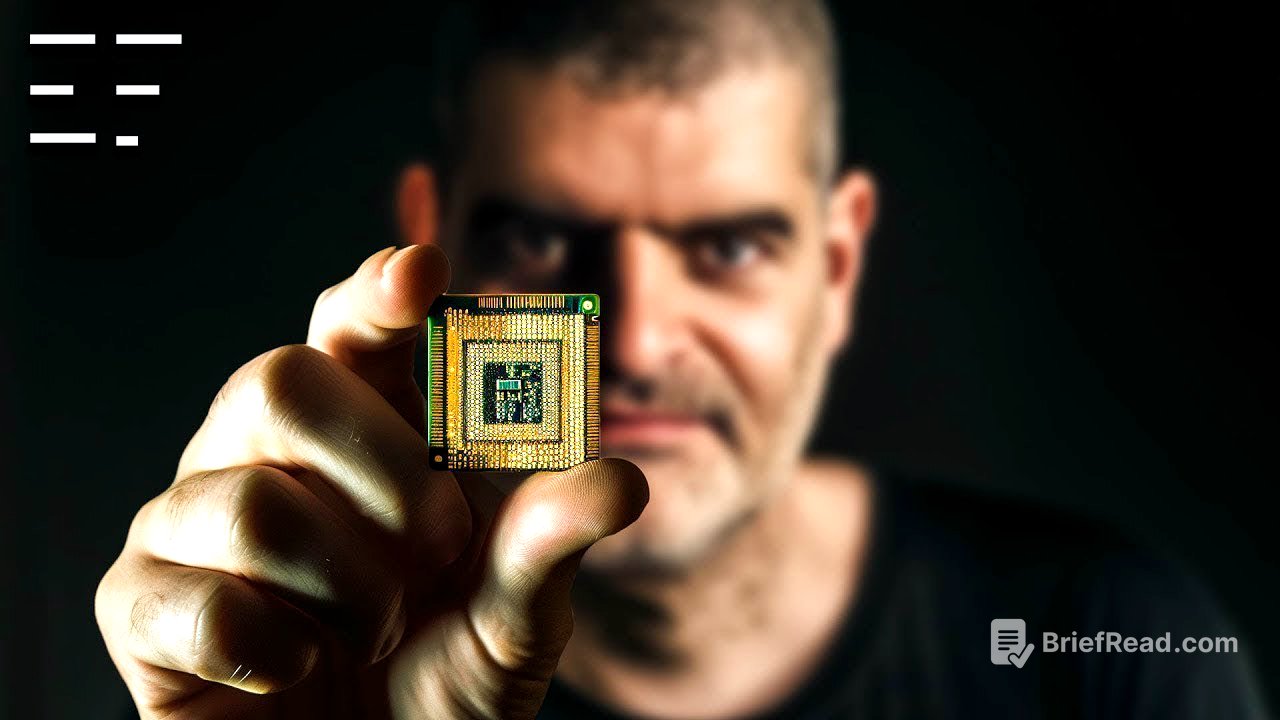TLDR;
Bernardo Kastrup argues against the notion of conscious AI, emphasizing the distinction between intelligence and sentience. He suggests that while AI can achieve high levels of intelligence, there's no basis to assume it possesses inner experience or consciousness. He critiques the arguments made by AI proponents, pointing out the flaws in equating simulations with reality and the dangers of projecting human-like qualities onto machines. Kastrup advocates for a more grounded approach, drawing insights from nature and cautioning against the cultural and psychological factors that fuel the belief in sentient AI.
- AI intelligence is distinct from sentience.
- Simulations of consciousness do not equate to actual consciousness.
- The debate around AI sentience is often driven by misconceptions and psychological factors.
Introduction [0:00]
The discussion starts by questioning the assumption of sentience in AI simply because it mimics human traits. The speaker highlights the human tendency to project consciousness onto models or simulations of ourselves, particularly in the age of AI. He contrasts this with our ability to easily distinguish between a simulation and reality in other contexts, such as mannequins. The speaker questions why we don't consider natural phenomena like lightning storms as conscious, despite their complex processes resembling neural activity in the brain. He emphasizes the role of computer scientists in promoting the idea of sentient AI, cautioning that their expertise lies in using computers rather than understanding their fundamental nature. The speaker introduces the concept of agency detection bias, our tendency to project qualities like consciousness onto phenomena we don't fully understand, and applies it to the modern fascination with AI.
Start of Lecture on Al and Consciousness [4:12]
Bernardo Kastrup begins by stating his intention to remain neutral regarding ontology, aiming for his arguments to be applicable regardless of one's ontological preferences. He differentiates between intelligence and sentience, acknowledging the reality and potential advancement of artificial intelligence, even to levels surpassing human intelligence. However, he questions whether this intelligence will be accompanied by inner experience, or sentience, similar to human consciousness.
Bernardo Kastrup's Background and Perspective [6:23]
Bernardo Kastrup shares his background in computer engineering, computer science, and philosophy, particularly in ontology and philosophy of mind. He emphasizes the importance of a philosophy of AI mind, if such a thing exists, given AI's computer-based nature. Kastrup acknowledges that his opinions might be wrong but asserts his relevant background in the field, contrasting himself with others who discuss AI without a similar foundation.
Early Career and Al Experimentation [7:41]
Kastrup recounts his early work at CERN, specifically on the ATLAS experiment, which involved processing vast amounts of data from proton collisions. He describes the development of a data acquisition system, or trigger system, that could quickly decide whether to store data based on its potential for new physics discoveries. He also mentions his parallel, unauthorized experiment using an artificial neural network to make similar decisions, which proved as effective as a physicist. Although the physics-based algorithm was ultimately used, the AI's performance sparked his interest in what it would take to make a computer conscious.
Challenges in Al Consciousness [10:43]
Kastrup emphasizes that intelligence and sentience are not naturally paired; intelligence is data processing for a specific goal, while sentience may or may not be intelligent. He reflects on his attempts to design a conscious computer, realizing that any changes he made would only affect its structure and function, not its potential for consciousness. This led him to question the assumption that material arrangements can generate experience, which he now considers fundamentally flawed.
Philosophical and Practical Implications [13:07]
Kastrup poses the question: if melted sand and metal (the components of a silicon chip) can be conscious, then what cannot? He extends this to everyday objects like home thermostats or even the sun, challenging the selective focus on AI. He argues that the use of electrons in computers is merely for convenience, as logic gates and memory elements can be built with alternative materials like water pipes and pressure valves. This analogy aims to demystify the technology and highlight the absurdity of attributing consciousness to such mechanistic systems.
Arguments & Critique of Al Sentience [15:45]
Kastrup critiques the arguments for AI sentience, which often begin by acknowledging the mystery of consciousness and then suggest that similar patterns of information flow between the brain and a silicon computer imply consciousness. He identifies this as an appeal to ignorance, vagueness, and abstract similarity. He uses the analogy of simulating kidney function on a computer to illustrate that a simulation of a phenomenon does not equate to the phenomenon itself, a principle that is readily accepted except when it comes to consciousness.
Obvious Differences Between Al and Human Brain [18:55]
Kastrup emphasizes the obvious differences between the human brain and a computer, highlighting their distinct compositions, power sources, and operational mechanisms. He argues that finding similarities requires excessive abstraction, which distances one from reality. He contrasts the complex electrical potentials in the brain with those in a lightning storm or a home thermostat, questioning why consciousness is not attributed to these phenomena as well.
Computer Scientists, Misconceptions & Sensationalism [21:32]
Kastrup addresses the argument that AI, like ChatGPT, must be sentient because it looks and sounds human. He counters that AI is designed to mimic human traits, similar to mannequins in a shop window. He explains that ChatGPT is a natural language interface that summarizes search results without understanding the content it presents. He criticizes the tendency to attribute authority to computer scientists on the topic of sentient AI, arguing that they are primarily power users who lack a deep understanding of the underlying hardware and processes. He attributes the hype around AI sentience to factors such as "woo delight," sensationalism, and a materialist worldview seeking a new form of religion.
Cultural and Psychological Factors [28:42]
The discussion shifts to the cultural and psychological factors driving the belief in sentient AI. Kastrup suggests that "womb envy," the desire to create new conscious life, may motivate some men to project consciousness onto AI. He also points out the influence of science fiction narratives, like those in "Black Mirror," which create a culturally manufactured sense of plausibility around consciousness uploading and downloading.
What Can We Learn From Nature About Consciousness? [29:50]
Kastrup shifts the focus to what nature tells us about consciousness. He asserts that our private, conscious inner lives are the primary datum of our existence. He notes that other living beings exhibit behaviors analogous to ours, suggesting a shared basis in conscious inner life. He highlights the commonalities among all living beings, such as metabolism and DNA, which distinguish them from everything else in nature. He argues that extrapolating sentience to other living beings is well-grounded, but doing so for a piece of melted sand and metal is a step too far.
Panpsychism and Its Flaws [35:11]
Kastrup addresses the counterargument that consciousness could be multi-instantiated, like flight in birds and airplanes. He acknowledges the possibility at a high level of abstraction but emphasizes the lack of understanding of the underlying mechanisms of consciousness. He argues that the idea of sentient silicon computers presupposes panpsychism, the notion that subatomic particles have a fundamental level of consciousness. He critiques panpsychism, arguing that there is no coherent way to explain how micro-subjectivities combine to form a conscious inner life.
Quantum Field Theory and Reality [38:27]
Kastrup presents his definitive argument against constitutive panpsychism, drawing on quantum field theory. He explains that elementary subatomic particles are not discrete things with spatial boundaries but rather excitations of underlying fields. He uses the analogy of ripples on a lake to illustrate that particles are behaviors or doings of the field, not independent entities. He argues that misinterpreting the term "particle" leads to flawed philosophical conclusions. He uses examples such as Quantum fluctuations, particle decay and inertia to support his argument.
Moving Forward with Clarity [43:44]
Kastrup concludes by emphasizing that the debate around artificial sentience involves more than just creating consciousness from non-consciousness; it implies a computer with a private inner life limited by its boundaries. He argues that attributing boundaries to inanimate objects is a linguistic convenience, not an ontological reality. He uses examples like rivers merging into oceans and boulders breaking off from hills to illustrate the absurdity of assigning consciousness based on linguistic categories. He suggests that the only entities with objectively definable boundaries are living beings.
Q&A Session [48:39]
During the Q&A session, Kastrup addresses questions about David Bohm's work, the importance of considering AI as non-conscious, the extent to which AI tools will influence human consciousness, and the distinction between awareness and sentience. He clarifies his views on Bohm's implicate order, emphasizing the need for an absolute existence to ground behavior and relations. He reiterates his commitment to truth and cautions against the manufactured plausibility of sentient AI in popular culture. He emphasizes that AI tools, like any tool, can be dangerous and require safety mechanisms. He refutes the redefinition of awareness to include AI, maintaining that sentience, or phenomenal consciousness, is what is being questioned.









